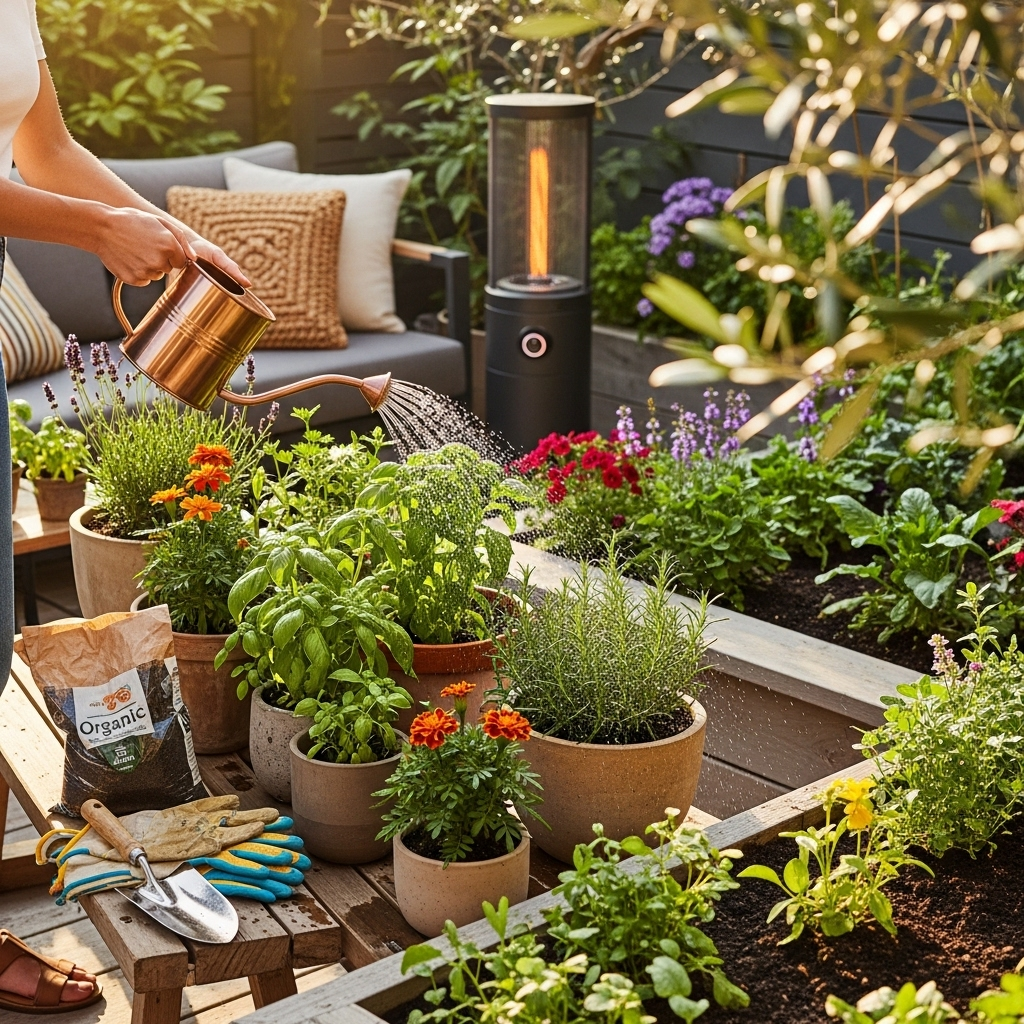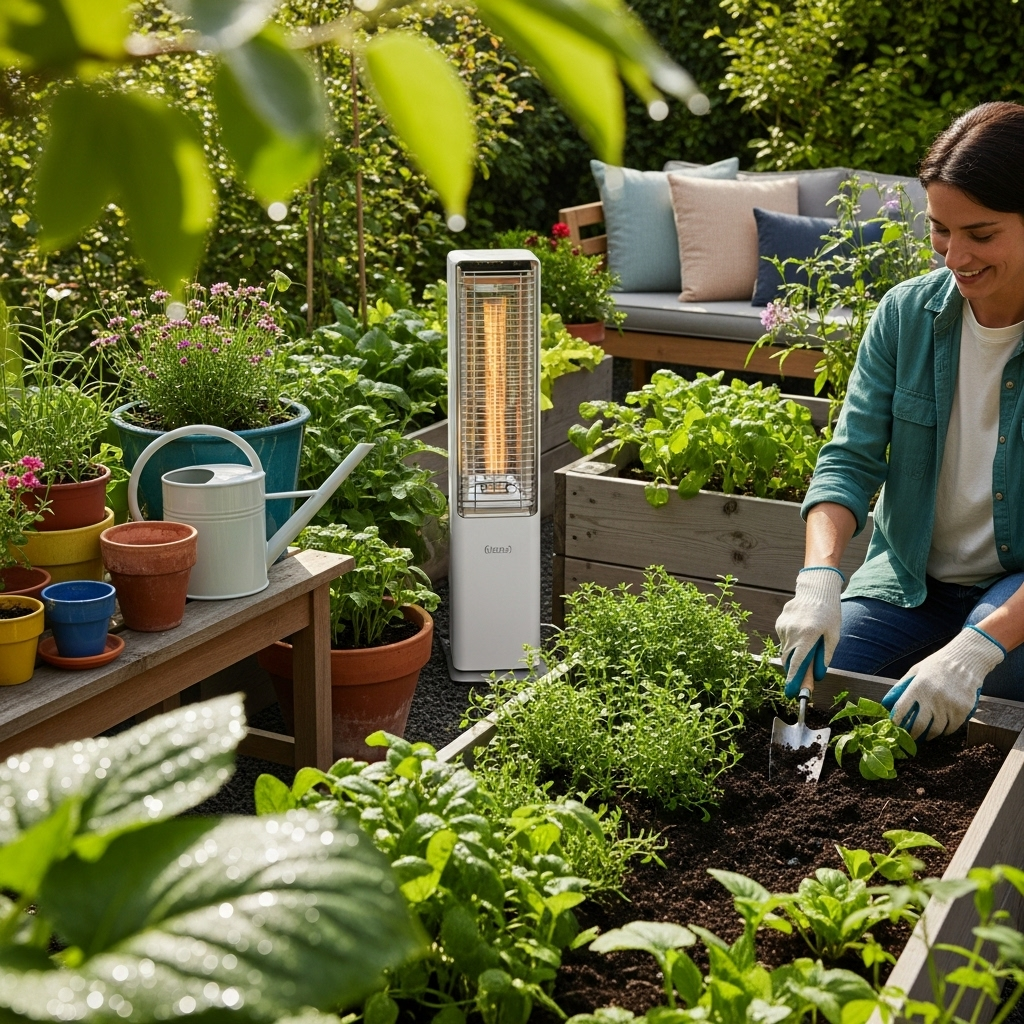Space heaters for outdoors can extend your enjoyment of patios, decks, and workshops into cooler months. Infrared heaters are often best for direct, targeted warmth, while propane or electric patio heaters offer broader coverage. Look for weather-resistant models and consider fuel source and heat output for your specific needs.
Brrr! Feeling that chill creep into your outdoor spaces? Whether you dream of cozy evenings on the patio, tending to your plants in a cool greenhouse, or enjoying a late-season barbecue, the dropping temperatures can be a real party pooper. It’s frustrating when your beautiful outdoor living area becomes unusable for most of the year. But don’t let the cold win! There are fantastic solutions to keep you warm and comfortable outside, no matter the season. We’re going to explore the best ways to bring cozy warmth to your patio, deck, or even your garage so you can keep enjoying your favorite outdoor spots. Get ready to discover how to beat the cold and extend your outdoor season!
Here’s a hint: It all starts with choosing the right kind of heater designed for the great outdoors.
Why Consider Outdoor Space Heaters?
As much as we love the warmer months, the reality is that temperatures can dip significantly, making outdoor activities less enjoyable. This is where outdoor space heaters come into play. They are specifically designed to provide warmth in open or semi-open environments, tackling the challenges of wind and ambient temperature much better than indoor heaters.
Think of your patio, deck, balcony, or even an unheated garage or workshop. These spaces often become underutilized when the weather turns cool. An outdoor heater can transform these areas into comfortable extensions of your home. It’s not just about personal comfort; it can also be about getting more value out of your property and creating inviting spaces for entertaining or relaxing year-round.
The benefits are plentiful:
- Extended Use of Outdoor Spaces: Enjoy your patio or deck for more months of the year.
- Enhanced Comfort for Entertaining: Keep guests warm and happy during outdoor gatherings.
- Increased Property Value/Usefulness: Make your outdoor areas more functional and appealing.
- Support for Gardening or DIY Projects: Maintain a comfortable temperature in workshops or unheated greenhouses.
Choosing the right outdoor space heater involves understanding the different types available and how to match them to your specific needs. Let’s dive into what makes a heater suitable for outdoor use and what options are proven to work.
Understanding Outdoor Heater Types

Not all heaters are created equal, and those designed for outdoor use have specific features and operate on different principles. The main types you’ll encounter are propane heaters, electric heaters, and natural gas heaters. Within these categories, the heating technology (like infrared or convection) also plays a significant role.
Propane Heaters
Propane heaters are incredibly popular for outdoor use because they offer portability and don’t require an electrical outlet. They work by burning propane contained in a portable tank, releasing heat. They are excellent for quickly warming larger areas.
Pros:
- Portability: Easily moved to different areas.
- Powerful Heat Output: Can heat large spaces effectively.
- No Electrical Outlet Needed: Ideal for remote patios or decks.
- Quick Warm-up: Heats up relatively fast.
Cons:
- Fuel Costs: Propane tanks need refilling, which can add up.
- CO Emissions: Require good ventilation to avoid carbon monoxide buildup.
- Tank Management: Need to monitor fuel levels and replace/refill tanks.
- Safety: Involves handling flammable gas, so caution is needed.
Electric Heaters
Electric outdoor heaters are a convenient option if you have a readily accessible outdoor power source. They are often quieter, don’t produce fumes, and can be more energy-efficient for targeted heating. They come in various forms, including patio heaters and infrared radiant heaters.
Pros:
- Clean Operation: No fumes or carbon monoxide.
- Energy Efficient: Can be more cost-effective for smaller or targeted areas.
- Easy to Use: Simply plug them in and turn them on.
- Quiet Operation: Less noise compared to propane models.
Cons:
- Requires Power Outlet: Limited by cord length and availability of outdoor-rated outlets.
- Heat Output Variability: Some models might not provide enough heat for very large or extremely cold spaces.
- Weather Dependency: More vulnerable to damage from harsh weather if not properly rated.
- Initial Cost: Some high-powered electric models can have a higher upfront cost.
Natural Gas Heaters
For those with a natural gas line connection outdoors, natural gas heaters offer a continuous and cost-effective heating solution. They are typically installed permanently and are a great choice for dedicated patio or deck areas.
Pros:
- Continuous Fuel Supply: No need to refill tanks.
- Cost-Effective: Natural gas is often cheaper than propane.
- Powerful and Consistent Heat: Good for larger areas.
- Eco-Friendly: Generally considered a cleaner burning fuel than propane.
Cons:
- Limited Portability: Requires a fixed gas line, making them stationary.
- Installation Required: Professional installation is usually necessary.
- Initial Setup Cost: Can be significant due to gas line installation.
- Not Suitable for All Locations: Need access to a natural gas line.
Infrared vs. Convection Heating
Beyond the fuel source, how a heater works is critical. Two primary methods are used:
- Infrared Heaters: These work like the sun, directly warming objects and people in their path. They emit radiant heat that is not affected by drafts or wind as much as convection heat. This makes them excellent for targeted warming in breezy outdoor areas. They can be electric or propane-powered.
- Convection Heaters: These heat the air around them, which then circulates. While effective indoors, convection heating is less efficient outdoors because the warm air can be easily dispersed by wind. Propane patio towers often utilize a combination, but direct infrared is preferred for open-air comfort.
Key Features for Outdoor Space Heaters
When shopping for a space heater for your outdoor oasis, certain features are non-negotiable to ensure safety, durability, and effectiveness. Since these units will be exposed to the elements, they need to be built tough.
Weather Resistance and Durability
This is paramount. Look for terms like “weather-resistant,” “outdoor-rated,” or specific IP (Ingress Protection) ratings. For electric heaters, this means seals that protect against rain and dust. For propane heaters, sturdy construction that can withstand wind and moisture is key. Materials like stainless steel or powder-coated finishes are excellent choices for longevity. A heater that can handle mild rain or splashes will last much longer.
Heat Output and Coverage Area
Heaters are rated in British Thermal Units (BTUs) or Watts. Higher numbers mean more heat. A small patio might only need 5,000-10,000 BTUs, while a larger deck could require 40,000+ BTUs. Understand the manufacturer’s recommended coverage area for the specific model you are considering. It’s often better to have a bit more heat output than you think you’ll need, as you can often adjust the settings.
Safety Features
Outdoor heaters can be powerful. Look for:
- Tip-over Protection: A mechanism that automatically shuts off the heater if it’s knocked over.
- Automatic Shut-off Timers: For convenience and to prevent overheating or unnecessary energy use.
- Protective Grills: To prevent accidental contact with hot surfaces.
- Thermostat Control: Allows you to set and maintain a desired temperature, preventing over-heating.
- For propane models: Oxygen Depletion Sensors (ODS) are a critical safety feature that shuts off the gas if oxygen levels drop too low.
Portability and Assembly
Do you need to move the heater frequently? Propane models, especially tower heaters with wheels, are designed for portability. Wall-mounted or permanently installed natural gas heaters offer less flexibility but more stable heat. Consider the weight and ease of assembly if you plan to store it during the off-season.
Fuel Source Considerations
As discussed, propane requires tank management, electric needs an outlet, and natural gas needs a line. Think about what’s most convenient and cost-effective for your setup. For example, if your deck is far from the house, an electric heater might require an outdoor-rated extension cord or permanent wiring, whereas a propane tank is a self-contained solution.
Proven Outdoor Space Heater Solutions

To make your decision easier, let’s look at some of the most effective and popular types of outdoor space heaters that have stood the test of time.
Patio Heaters: The Quintessential Choice
These are what most people envision when thinking of outdoor heating. They are typically tall, freestanding units designed to radiate heat downwards and outwards.
Propane Patio Heaters:
These are the workhorses of outdoor heating. They house a standard propane tank (often a 20lb tank) at the base and have a heating element at the top. They can generate a significant amount of heat, making them ideal for patios, decks, and even outdoor restaurant seating. Look for models with sturdy bases and efficient burners.
Example Brands: Hiland, Dyna-Glo, AmazonBasics.
Electric Patio Heaters:
These often resemble their propane counterparts in shape but plug into an outlet. They offer cleaner operation and are generally quieter. Some can be mounted on walls or ceilings for a less intrusive setup. They excel at providing quick, directional warmth.
Example Brands: Bromic Heating, DEWALT.
Natural Gas Patio Heaters:
These are permanent installations, connected via a gas line, providing an uninterrupted and often more economical heat source for larger, fixed outdoor living spaces. They are excellent for restaurants or large residential patios.
Infrared Heaters: Targeted Warmth
Infrared (or radiant) heaters are fantastic because they emit heat waves that directly warm people and objects without needing to heat the air in between. This makes them incredibly effective outdoors, as wind won’t dissipate the heat as quickly. They are often more energy-efficient for personal comfort.
Electric Infrared Heaters:
These are commonly wall-mounted or ceiling-mounted, focusing heat on a specific area, like a seating arrangement. They are a great choice for balconies or covered patios where you want targeted warmth without a large floor unit. The American National Engineering Council (ANECHO) highlights that radiant heating can be more efficient in certain applications by directly addressing occupants without extensive air circulation, reducing energy loss.
Example Brands: Dr. Heater, Mr. Heater (offers both propane & electric infrared).
Propane Infrared Heaters:
These are less common than propane convection patio heaters but offer the benefits of infrared heating with propane’s portability. They are excellent for workshops or garages where electricity might be limited but targeted warmth is needed.
Tabletop and Portable Heaters for Small Spaces
For smaller areas like balconies, RV patios, or small decks, tabletop and smaller portable heaters are a great solution. They can be propane or electric.
- Tabletop Propane Heaters: These are compact, often designed to sit on a table or railing, providing localized warmth.
- Small Electric Portable Heaters: Many compact electric heaters designed for patios are available. Ensure they have appropriate weather-resistant ratings.
Selecting the Right Heater for Your Needs
Choosing the best outdoor space heater involves considering a few key questions about your specific situation. Let’s walk through a simple decision-making process.
Step 1: Assess Your Space
Size: How large is the area you want to heat? A small 6×8 foot balcony needs much less power than a 20×20 foot deck.
Enclosure: Is it fully open, partially covered (like a pergola), or fully enclosed (like a sunroom or garage)? Partially enclosed spaces retain heat better.
Wind Exposure: Is the area prone to strong winds? If so, infrared heaters are generally more effective.
Step 2: Determine Your Power Source
Electricity Available? Do you have easy access to an outdoor-rated electrical outlet? If yes, electric heaters are a clean and convenient option.
Propane Tank Access? Are you comfortable managing propane tanks? This is a great option for portability and power.
Natural Gas Line? Is your outdoor space connected to a natural gas line? This offers the most convenience and potentially lower fuel costs for fixed locations.
Step 3: Consider Your Primary Use
Entertaining? You might need broader heat coverage and a stylish design.
Gardening/Workshop? Targeted warmth and portability might be more important.
Solo Relaxation? A smaller, efficient infrared heater could be perfect.
Step 4: Set Your Budget
Outdoor heaters range from under $100 for small electric or tabletop propane models to over $500 for high-end, powerful patio heaters or permanently installed units. Remember to factor in ongoing fuel costs (propane, natural gas, or electricity).
Heater Selection Cheat Sheet
To help visualize your choices, here’s a quick comparison:
| Scenario | Recommended Heater Type | Key Features to Look For |
|---|---|---|
| Small Balcony (Partially Covered) | Electric Infrared Wall-Mounted or Tabletop Propane | Compact size, adjustable heat, weather-resistant (for electric), tip-over protection. |
| Medium Deck (Open Area) | Propane Patio Heater or Powerful Electric Patio Heater | BTU output of 40,000+, sturdy base, tip-over safety, wide heat radius. |
| Large Patio/Entertainment Area (Covered or Near Gas Line) | Natural Gas Patio Heater or High-BTU Propane Patio Heater | Permanent installation if using NG, high BTU output, durable construction, multiple heat settings. |
| Unheated Garage or Workshop | Electric Infrared or Portable Propane Heater | Targeted heat, safety grills, durable build, portability. Ensure proper ventilation for propane. |
| Budget-Conscious Small Outdoor Nook | Small Electric Heater or Compact Propane Tabletop | Affordability, ease of use, basic safety features, appropriate wattage/BTU for the small space. |
Installation and Safe Operation

Once you’ve chosen your outdoor space heater, proper installation and safe operation are crucial. Even the most advanced heater can be unsafe if not used correctly.
Installation Check List
Read the Manual: This is the most important step. Every heater has specific installation and operating instructions.
Assembly: For freestanding units, ensure all parts are securely attached, especially the base, for stability. If mounting, use appropriate hardware for your wall or ceiling material.
Propane Tanks: Ensure the tank is properly connected with a leak-free seal. Do not use a damaged tank. Always handle propane tanks upright and in a well-ventilated area.
Electrical Connections: For electric heaters, use only outdoor-rated extension cords if needed, and plug into GFCI (Ground Fault Circuit Interrupter) protected outlets. Avoid overloading circuits. The Occupational Safety and Health Administration (OSHA) emphasizes GFCI protection for electrical safety in damp or wet conditions.
Natural Gas: This typically requires professional installation by a licensed plumber or gas technician to ensure proper connection to the gas line and safety checks.
Safe Operation Tips
Clearance: Always maintain adequate clearance around the heater. The manual will specify safe distances from walls, furniture, plants, and other combustible materials. Typically, this is at least 1 to 3 feet, but can be more for powerful units.
Ventilation: Never use propane or natural gas heaters in enclosed spaces without adequate ventilation. Carbon monoxide (CO) is a colorless, odorless gas that can be deadly. Ensure airflow to prevent buildup.
Supervision: Never leave a lit outdoor heater unattended, especially around children or pets.
Weather: While rated for outdoors, extreme weather conditions (heavy rain, snow, high winds) can still pose a risk. Consider covering or storing your heater during such times.
Maintenance: Regularly inspect your heater for damage, rust, or wear. Clean burners and reflectors as per the manufacturer’s instructions.
Storage: When not in use, store your heater in a dry, safe place, ideally with a protective cover.
Eco-Friendly Considerations
While the primary goal is warmth, we can also be mindful of our environmental impact. Here are a few points to consider:
- Energy Efficiency: Infrared heaters are generally more efficient for targeted heating as they don’t waste energy heating empty air.
- Fuel Source: Natural gas is often considered a cleaner fuel than propane, though both are fossil fuels. Electric heaters can be eco-friendly if your electricity comes from renewable sources.
- Longevity: Investing in a durable, high-quality heater that lasts for many years is more sustainable than replacing cheaper models frequently.
- Usage Habits: The most eco-friendly approach is to use your heater only when necessary, at the lowest effective setting, and for the shortest duration needed.
FAQs about Outdoor Space Heaters

Q: Can I use an indoor space heater outside?
A: No, it is not recommended. Indoor heaters are not designed to withstand outdoor elements like rain, wind, and temperature fluctuations, making them unsafe and likely to break. Always use a heater specifically rated for outdoor use.
Q: How much heat output (BTU/Watts) do I need for my patio?
A: For a small patio (around 100 sq ft), 10,000 BTUs might suffice. For larger areas (200-400 sq ft), 40,000 BTUs or more are often necessary. Consider wind exposure – breezy areas need more powerful heaters.
Q: Are propane heaters safe for partially enclosed areas like a screened-in porch?
A: Use extreme caution. While some propane heaters can be used in partially enclosed spaces, you must ensure there is adequate ventilation to prevent carbon monoxide buildup. Always check the manufacturer’s guidelines and ensure the space is not fully enclosed.
Q: How long does a standard 20lb propane tank last in an outdoor heater?
A: A typical 40,000 BTU propane patio heater consumes about 1.5 to 2 lbs of propane per hour. A 20lb tank would therefore last roughly 10-13 hours on high heat. This varies greatly depending on the heater’s BTU output and the setting you use.
Q: What is the difference between propane and electric outdoor heaters?
A: Propane heaters use bottled fuel for high heat output and portability, ideal for areas without power. Electric heaters require a power outlet, are cleaner, quieter, and often more energy-efficient for targeted warmth, but their portability is limited by cord length.
Q: Do I need to cover my outdoor heater when not in use?
A: Yes, using a weather-resistant cover is highly recommended. It protects the heater from rain, dust, UV rays, and other elements, prolonging its lifespan and keeping it ready for use. Ensure the heater is completely cool before covering it.
Q: Are infrared heaters better for windy patios?
A: Generally, yes. Infrared heaters emit radiant heat that directly warms objects and people, and this type of heat is less affected by wind compared to convection heat (which warms the air). This makes them a more efficient choice for open or breezy outdoor spaces.
Conclusion: Embrace Warmer Outdoor Living
Don’t let the changing seasons dictate when you can enjoy your outdoor spaces. With the right outdoor space heater, your patio, deck, balcony, or workshop can become a comfortable haven for more of the year. Whether you opt for the robust heat of a propane patio heater, the clean convenience of an electric infrared model, or the continuous warmth of a natural gas unit, there’s a proven solution perfectly suited to your needs.
Remember to prioritize safety features, consider your space and power source, and always follow the manufacturer’s instructions for installation and operation. By making an informed choice, you’re not just buying a heater; you’re investing in extended enjoyment, enhanced comfort, and more memories made in your beloved outdoor areas. So go ahead, extend your season, and embrace the cozy outdoors!
